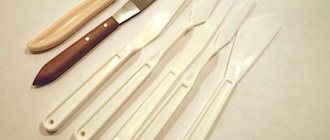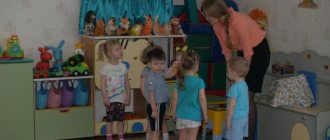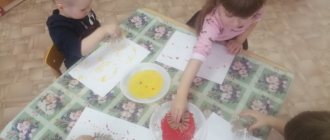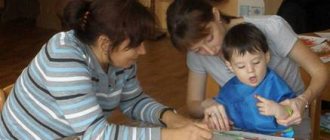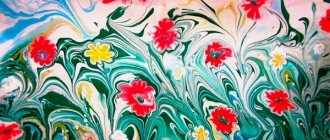Psychologists have long proven that drawing has a beneficial effect on the child, the development of his speech, imagination, fine motor skills and coordination of movements. And parents who, for one reason or another, had to contact a child psychologist with their baby, probably know that at the beginning of the appointment, the specialist asks the child to draw a picture - of his family, friends or beloved pet. Experts have found that with the help of drawing, the toddler best understands the world around him.
The benefits of drawing for child development
Drawing for children 5-6 years old not only brings pleasure, but is also an excellent way to improve creative and intellectual skills. Children in preschool age think figuratively, so creating new images and regular drawing classes contribute to their better development.
Drawing lesson in kindergarten
During creative activity, the child experiences the following changes:
- development of creativity;
- the ability to create many new images and change details at your discretion;
- the ability to associate one's works with objects, people or animals.
Note! Playing associations in the process of creating a picture helps to train imagination, mind, thinking, and also represents a replacement for the most modern methods of child development.
Long-term lesson plan for children 4–5 years old “Non-traditional drawing techniques”
Natalia Buchanova
Long-term lesson plan for children 4–5 years old “Non-traditional drawing techniques”
Long-term lesson plan
for children 4-5 years old
No. Topic Non-traditional technology Purpose of the lesson Equipment
September
1 "Vase with leaves"
Imprint of a dried leaf.
Introduce children to the technique of drawing - plant imprint .
Learn to mix paints on a sheet of maple paper, picking up colors of autumn colors. A4 paper, gouache, dried maple leaf, brushes. napkin, printing paper. 2. "Butterfly"
Making an image of a butterfly using imprints of dried leaves.
Practice leaf printing techniques .
Learn to add details to an image. A4 paper, tinted, dried leaves, brushes, various gouache, printing paper. 3. “I love fluffy things”
.
drawing
. Introduce the technique of poking with a hard , semi-dry brush. Learn to draw an outline of an animal with a simple pencil, draw the fluffy fur of an animal with a poke. Learn to complement the drawing with details. A4 paper, pencil, gouache, brush, napkin, water.
4. Paper toning. Drawing in the raw . Teach children to tint paper themselves and prepare them for drawing in the next lessons .
Strengthen watercolor painting . Develop color perception.
A4 paper, watercolor, brushes. water.
October
5. "Sunflower"
Poking.
Learn to draw the stem and leaves of a sunflower. Strengthen gouache drawing .
Develop a sense of composition. Blue paper, gouache, brushes.
6. "Dry bouquet"
Sticking dry dried plants. Learn to make a beautiful composition, cut out a vase from cardboard, make a bouquet of dried plants and leaves.
Improve your ability to use glue. A3 paper, dried leaves, plants. PVA glue, scissors. cardboard.
7. "Currant"
Leaf print,
finger painting . Introduce children to typing.
Continue learning to draw trees and branches: long, short, thin, thick. Tinted paper with a painted twig , green, black, brown gouache, paper for prints, napkin.
8. “This hedgehog is not simple.
this hedgehog is a sea hedgehog.” Drawing with crumpled paper and pastels. Introduce a new technique of drawing with crumpled paper .
Continue to develop the ability to freely use a pencil when performing a linear drawing. Learn to create a pastel background, develop an idea of diversity. A4 paper. hard brushes, brown gouache, image of a hedgehog. 9. “Aquarium”
Drawing with cotton swabs . Continue learning to draw with cotton swabs , paint fish, seaweed, and pebbles.
Develop a sense of composition. Cultivate neatness. A4 paper, cotton swabs.
10. “A swan swims on the sea”
Palm drawing . with chopsticks. Practice drawing with your palm . develop imagination, creativity, and cultivate interest in insects. Practice drawing with your palm .
Develop imagination and creativity.
Complete the image with your fingers. Cultivate an interest in insects.
11. "Autumn Tree"
Printing from leaves and sanguine charcoal Introduce the techniques of printing from leaves.
Practice drawing with charcoal and sanguine .
Tinted paper A4, dried birch leaves, charcoal. sanguine, gouache. 12. “Mushrooms in a basket”
Printing with signets,
finger painting . Practice drawing oval-shaped objects, consolidate the ability to decorate objects with a simple pattern using finger painting , and develop a sense of composition.
gouache, brushes, basin of water, hand napkins, gram, recording of Ossetian melodies. November
13. “Riddles from the garden”
Drawing with wax crayons , watercolors Practice drawing vegetables or fruits lying on a plate with wax crayons, practice classifying
objects. cultivate neatness Paper in the shape of a circle, wax crayons, watercolor. brushes, napkins, water.
14. “Draw balloons and decorate”
Drawing with wax crayons . watercolors Learn to draw oval-shaped objects, consolidate the ability to place drawings over the entire surface of the sheet.
Practice decorating drawings with printing. Sheet of tinted A4 paper, gouache, brushes. 15. “Fluffy kitten”
Poking Practice using a hard or semi-rigid brush. Learn to draw a kitten with a simple pencil and then by poking. Learn to complement the drawing with details.
A4 paper, pencil, gouache for poking, brushes, napkin, water.
16. “Red fox” Poking with a hard semi-dry brush Develop the ability and interest in the animal world, its diversity, and enrich vocabulary. Learn to draw using the poking method , expand children's knowledge about wild animals , and strengthen the ability to select colors. Gouache, brushes, paper.
17. “Magic pattern”
Drawing with a thread Introduce children to a new drawing technique for them . learn to fill in the missing details , develop fantasy and imagination.
A4 paper (2 sheets, gouache, plastic spoon or stick, medium-thick thread. 18. “Bird House”
Drawing with cotton swabs , wax crayons, pencils and watercolors. Develop imagination, creative initiative, consolidate knowledge about geometric shapes and the ability to draw them , cultivate a caring attitude towards birds. A4 paper. cotton swabs. wax pencils, watercolors. brushes, napkins.
19. “Decorate a handkerchief”
Drawing with cotton swabs and dipping Learn to decorate a handkerchief with a simple pattern, using cotton swabs and dipping, develop a sense of Square-shaped paper, cotton swabs, watercolors, brushes
20. “According to plan”
Various Improve skills in free experimentation with materials, develop a sense of composition. All available.
December
21. “Snowflakes”
Drawing with a candle Introduce a new technique of drawing with a candle . Learn to draw snowflakes, big and small.
placing it over the entire sheet, consolidate the ability to paint over the entire sheet with watercolors. A4 paper, watercolor, candle, wide brushes No. 18. 22. "Snowman"
Crumpling paper Strengthen the skills
of drawing with gouache , the ability to combine rolling in work. Learn to paint missing objects with a brush, develop a sense of composition.
A4 paper, napkins, glue, brushes, gouache. 23. “The Road to Santa Claus”
painting and tearing Strengthen children’s ability to stick , continue to teach finger painting , develop a sense of color, rhythm, and cultivate neatness.
Paper 5*10, gouache, brush, glue. colored paper 24. “New Year tree”
drawing and cutting (team work)
Continue teaching
children to draw with their palm , select the colors of winter.
learn to cut A4 paper, gouache, brushes, scissors. 25. "By Design"
Various Improve skills in free experimentation with materials, develop a sense of composition. All available.
26. "Christmas balls"
Applique and
finger painting , gel pens Reinforce knowledge about the round shape. learn to draw beads with your finger , cultivate accuracy.
Colored paper, scissors, glue, gel pens
27. "Beautiful candles"
Applique and
drawing with wax crayons Improve the technique of drawing with wax crayons, continue to learn how to cut a rectangle from a square, develop creative imagination, and cultivate the desire to bring joy to people around you.
Paper in the shape of a circle. wax pencils, 4*4 square, glue. brushes, napkin 28. “New Year's card”
Drawing with sanguine and appliqué Learn to create a composition for a greeting card, improve the technique of drawing with sanguine , develop a creative image, cultivate a desire to bring joy to people Square paper, sanguine, glue.
brush, postcards on a New Year theme. January
29. "Puppy"
Poking with a hard semi-dry brush Learn
to draw dogs , expand knowledge about pets, continue to introduce the technique of poking with a hard , semi-dry brush. Strengthen the ability to hold a brush correctly, draw the fluffy fur of an animal with a poke, learn to complement the drawing with details.
A4 paper. gouache for poking. brushes, napkins. 30. “Firebird”
Drawing with cotton swabs and wax crayons, watercolors. Continue to develop interest in collective activities, when depicting bird feathers, train children in using the technique of color contrast in drawing .
Firebird feather blanks, wax crayons, cotton swabs, paints, brushes. 31. “Kokoshnik, crown Decorative applique Arouse interest in the design of headdresses. Initiate an independent way of decorating products, develop a sense of shape and color, select a harmonious color combination, build a pattern alternating decorative elements, and cultivate artistic taste in children . Paper in the form of a kokoshnik, crown, colored paper, glue, brushes
32. “Patterns on glass” Drawing
(Gzhel painting)
Continue to teach to see the originality, beauty, tenderness of Gzhel painting;
To encourage and show imagination and independence in creating patterns based on Gzhel painting; teach how to create teamwork; consolidate the ability to draw a brushstroke with a shade . Jug-shaped paper, blue gouache, brushes
33. “Patterns from a fairy tale” Drawing
with a thread Exercise in drawing a pattern with a thread , cultivate a desire to draw , consolidate knowledge about cold and warm colors. A4 paper, various gouache, brushes, sticks for working with thread, napkins.
34. “Bunny” Drawing with cotton swabs and foam rubber. Continue to teach children to draw with cotton swabs and foam rubber, expand children’s knowledge about animals , and instill an interest in poetic works. A4 blue paper, white gouache, cotton swabs, foam rubber.
35. “Bullfinch” Poking with a hard, semi-dry brush. Teach children to draw birds , expand children’s knowledge about wintering birds , continue to teach children to draw with a poke along the contour with a hard brush, complete the small details of the drawing with the end of the brush, and develop aesthetic perception. A4 paper, gouache of different colors, brushes.
36. "By design"
Various Improve skills in free experimentation with materials, develop a sense of composition. All available.
February
37. “Pattern on a square” Finger painting . Improve the ability to draw with fingers , introduce the technique of pointillism ( drawing with dots) , develop a sense of color, rhythm, and cultivate accuracy.
Light tinted paper 21x21 cm, gouache in different colors, napkin.
38. “Let’s feed the birds in winter” Drawing with charcoal and watercolors . Learn to draw birds , develop an understanding of color and color shades, encourage creative initiative, cultivate a desire to help animals and birds. A4 paper, watercolor, charcoal, brushes.
39. "Magic Flower"
(1 part)
Modeling with the addition of decorative elements.
Encourage children to use the modeling techniques available to them to convey fabulous images of flowers, achieving expressiveness by introducing other objects (small objects, paper, foil, seeds of berries and fruits)
to develop the fantasy and imagination
of children .
Plasticine, board, stacks, sketches of fairy-tale characters, decorative elements, 0.5 album sheet. 40. “Magic Flower”
(Part 2)
Modeling with the addition of decorative elements.
Encourage children to use the modeling techniques available to them to convey fabulous images of flowers, achieving expressiveness by introducing other objects (small objects, paper, foil, seeds of berries and fruits)
to develop the fantasy and imagination
of children .
Plasticine, board, stacks, sketches of fairy-tale characters, decorative elements, 0.5 album sheet. 41. “Spring Sun” Drawing with a palm Strengthen the ability to draw using the technique of palm printing , learn to mix different colors on the palm. A4 paper, gouache.
42. “Floral pattern” Optional Teach children to draw a flower pattern , filling the entire space of the object, find a beautiful combination of colors, improve drawing . Paper cut in the shape of a glass, saucer
43. “Pattern in a circle” Spraying with a toothbrush. Continue to introduce the spraying technique , teach how to hold the brush correctly so that the splashes fall on the paper, strengthen the ability to draw a pattern in a circle , and independently select leaves for the pattern. Round paper, dried leaves, watercolor, toothbrush, newspaper.
44. “Nuts for a squirrel” Poking with a hard semi-dry brush, cotton swabs, impression with a cork. Improve the ability to draw with a poke , obtaining a textured image, learn to draw a squirrel , complete small details with cotton swabs, use a cork impression to draw nuts , cultivate accuracy.
A4 paper, cotton swabs, hard brush, corks, gouache, napkin, water.
March
45. Postcard for mom “Bouquet of Flowers” Rolling balls from colored paper Develop a sense of composition, practice the technique of rolling paper into balls and cultivate love and attention to loved ones, the desire to please them. Practice composing a composition, learn to cut out mimosa leaves, and develop aesthetic perception. Postcard blank, A4 cardboard red, blue, PVA glue, brown paper for branches, scissors
46. “I want to fly in a hot air balloon...”
Drawing
with wax pencils and pastels. Continue to get acquainted with modes of transport, learn to paint over an outline, create a background for the picture being depicted, develop the technique of drawing a circle , straight lines, and imagination about the variety of colors and shades. A4 paper. Watercolor. Wax pencils, pastels.
47. “The tree looks into the lake” Monotype Continue introducing children to the monotype technique . Learn to compose a harmonious composition. Cultivate an interest in learning about nature. A4 paper, watercolor, brush.
48. “Owl” Poking with a hard semi-dry brush. Improve the ability to draw with a poke , obtaining a textured image, learn to draw an eagle owl , paint small details with a brush, and cultivate accuracy.
Blue A4 paper, pencil, hard brush, gouache, napkin, water.
49. “Golden Khokhloma” Decorative drawing Continue to introduce children to the products of Khokhloma crafts, learn to draw elements that determine the specifics of “Golden Khokhloma”, and create the simplest floral patterns in the style of Khokhloma painting. Develop the ability to use a brush, cultivate interest in folk art. Paper in the form of cutting disks, gouache, brushes.
50. “I’ll draw the sea…. » Drawing on wet . Continue to introduce types and genres of fine art, create conditions for experimentation, learn to reflect your ideas about the sea, paint with watercolors using the “wet” technique. Develop creative imagination, cultivate interest in learning about the world. A4 paper, watercolors, brushes, reproductions of paintings by marine painters.
51. “Inhabitants of the Sea” Application and felt-tip pens, helium pens Continue introducing children to the inhabitants of the sea . Improve the technique of silhouette appliqué, cutting according to a drawn outline , develop a sense of shape and proportion, and cultivate interest in natural phenomena. Children's drawings made in the last lesson , felt-tip pens, gel pens, scissors, glue, colored paper
52. “Cherry” Poking with a hard semi-dry brush. Learn to draw berries , improve your drawing technique . Yellow paper, gouache, brushes.
April
53. “Ducklings on the pond” Drawing with cotton swabs and poking with a hard, semi-dry brush. Learn to draw ducklings floating on the water, improve the poke drawing technique , and develop a cognitive interest in nature. Cardboard of any color, PVA glue. Scissors. eggshell, paper.
54. “Butterflies” Poking with a hard semi-dry brush.
Expand knowledge about insects, cultivate a caring attitude towards them. A4 paper, watercolor, brushes.
55. “Space” Drawing with sanguine and spraying with a toothbrush Expand children's horizons, knowledge about space , develop color perception. Continue to learn how to tint paper with various materials, pouring color into color by spraying. Encourage independence, develop accuracy, cultivate the desire to work in harmony, together. A4 paper, sanguine, gouache, toothbrush.
56. “Sea Kingdom” (grattage)
Convey in the drawing not only the shape, but also the plasticity of the object, its character with the help of small details, introduce
drawing using the grattage technique .
Sticks for scratching. 57. “The rooks have arrived” Poking with a hard, semi-dry brush. Strengthen the ability to draw using the poking method , expand children's knowledge about migratory birds . Blue A4 paper, pencil, hard brush, gouache, napkin, water.
58. “Magic Flower” Matchbox prints. Expand children's ideas about seals and the possibility of waste material. Strengthen the ability to work in printing techniques , learn to draw a beautiful flower . A4 paper, stamp pad, matchboxes, 2-3 for each child, napkin.
59. “Starry Sky” Spraying, foam rubber stencil printing. Improve the ability to work with the technique of sprinkling small stars with a toothbrush, consolidate knowledge of painting genres. Dark paper, toothbrush, gouache, star stencils, foam swabs, napkins.
60. “By design” Various Improve skills in free experimentation with materials Develop a sense of composition. All available.
May
61. “Flowers” Technique of blowing through a tube and dipping Practice drawing by blowing a stream of air onto a drop of liquid paint, learn to blow through a tube so that the drop moves to the sides and you get a star. Learn to draw by dipping leaves around one flower. A4 paper, pen tube, red or blue ink, brushes, water, napkins.
62. “The dandelions have blossomed” Drawing with a poke with elements of applique (team work)
Strengthen the ability to reflect holiday impressions in a drawing; develop the ability to correctly evaluate your own work and the work of your comrades; learn to create a general work from individual parts; develop the ability to work together without interfering with each other. Corrugated paper of various shapes.
63. “By design” Various Improve skills in free experimentation with materials Develop a sense of composition. All available.
64. Exhibition design for parents Teach children to choose
Paste 1-2 of your best works onto common paper, instilling a desire to please loved ones. Children's works for selection for the exhibition. PVA glue, wallpaper for gluing works.
How to get your child interested in drawing
If a preschooler has even the slightest craving for drawing, parents should think about developing his abilities. To prevent your child from losing interest in creativity, you can enroll him in an art club, studio, or resort to individual training with a private teacher.
It is strictly not recommended to enroll a child in a specialized institution against his will. The toddler must attend classes with pleasure, otherwise it will not bring any results.
Should I send my child to a drawing class?
Today, many parents send their children to specialized clubs. Here the children feel good, as they not only learn artistic activities, but also communicate with their peers. Before you take your child to classes, you need to make sure that he is really interested in this type of art.
Should a child attend a club?
Note! Do not forget that preferences in preschool age are unstable, so today the little one wants to study at an art school, but tomorrow he doesn’t.
Image techniques
Popular methods and techniques of depiction are represented by the use of nature, reproductions of paintings, a sample or any other visual aid. A nature is an object or phenomenon that a child must draw in the process of direct observation. At early preschool age, children can already perceive an object in the totality of its qualities.
But it is worth noting that depicting an object using a template or from life requires the ability to analyze the relationship of individual elements and their location in space.
Training and education of children with mental retardation using a correction program
Workspace organization
In order for a preschooler to be able to draw at home, he needs to prepare a workplace. The child must see the entire image, so to draw, you should take an easel or draw on the floor. Special attention should be paid to lighting, since the light should fall from the opposite side from the hand with which the baby is drawing.
An example of organizing a workplace for children
As for working materials, the water should be on the right (if the baby is left-handed, then on the left), the paints should be above the drawing or near the water, and the palette for mixing colors should be in the hands. If the palette stands near the paints, then during the work you can accidentally drip onto the painting, ruining it.
Drawing tools
Drawing lessons for children 4-5 years old include the following steps:
| № | Stage | Description |
| 1 | Think about the upcoming lesson | In your head you need to scroll through the sequence of actions that the young student will perform |
| 2 | Prepare materials and tools | For work you will need sheets of A4 paper. For example, a drawing can be made in an album. The main tools will be pencils, felt-tip pens or paints. If paints are selected, you will additionally need:
|
| 3 | Prepare non-standard tools | In addition to basic items and materials, items that have a different purpose may be required. For example, for painting with paints you can use:
Children will also enjoy painting with their fingers, without any tools. Another unusual way of painting is to use a large piece of wallpaper. The drawing is done on the reverse side, which is white. In this case, the result is not just a picture, but a whole composition. It can be performed by several children at the same time together with adults. |
| 4 | Run sample drawing | This will make the material easier to explain. For example, you can take for classes:
The child will happily support his toy teacher, trying to help him |
| 5 | Prepare additional materials | They will help make the lesson more interesting and fun. It can be:
|
Where to start when teaching a child to draw
Drawing with children 5-6 years old is not only the process of creating an image with paints or colored pencils. A young creator may prefer other techniques, so parents should first buy their child felt-tip pens, gouache or watercolors and crayons.
Techniques for developing drawing skills
It is not at all necessary to apply paint to paper with a brush, because for this you can use foam sponges, cotton swabs or threads. Each technique is capable of developing certain skills in a preschooler: some will be better, and some will be worse.
Important! Parents must remember that constant criticism can discourage children from creating. Because of failures, the little one is often upset and disappointed, so he should be supported.
Interesting drawing ideas
In the process of creating a picture, you can invite children to draw a fictional planet with its nature and fantastic animals, after which it will be interesting to name it. Another unconventional drawing idea for 5-year-olds is to create a still life or autumn landscape using feathers, which you dip in paint and make fancy designs on a sketchbook sheet. The result should be interesting and original work.
Class notes
Theme of the week: “I take one berry”
Lesson 1. Branch with berries (Drawing with colored pencils)
Program content.
Continue to introduce children to the variety of berries. Learn to copy from a picture, correctly convey the shape of the leaves, location and color of the berries. Strengthen the ability to fill out a sheet compositionally.
Demonstration material.
Subject pictures with drawn branches or bushes with berries (red currants, black currants, gooseberries, raspberries, strawberries, wild strawberries, etc.).
Handout.
Halves of album sheets, simple and colored pencils.
How to teach a child to draw with pencils and paints step by step
In order for the toddler to draw with a pencil, you need to help the child hold it in the correct position. The parent should take the child’s hand with a pencil in his own, and then draw straight and wavy lines and simple shapes together. As soon as the preschooler masters simple large forms, you can complicate the tasks and begin to depict small details: a hare, a bullfinch, flowers in the spring or snowflakes in the winter.
Drawing lesson on the theme “Girl dancing” for the middle group
As for learning to work with paints, it consists of several stages:
- prepare soft bristle brushes, a sippy cup, watercolor paints and a palette;
- teach your child to hold a brush and use it: pick up paint, apply it to the easel, blot and rinse;
- At the first stage, the little one must move a dry brush over the paper, determine the degree of pressure and the correctness of the movements.
The process of learning to paint with paints
You should draw step by step, starting with one color, gradually adding other shades. To begin with, it is recommended that the child draw strokes according to the diagram, lines and simple figures from closed contours to be painted.
Recommendations from psychologists and teachers
According to Daria Nikolaevna Koldina’s notes (which are available online), teachers do not recommend overloading children during drawing classes, otherwise, instead of enjoying a rich and interesting life, the little one will suffer from fatigue and frayed nerves. If perseverance is not one of the child’s virtues, then there is no need to force him to study, since he must come to this on his own.
As for the break between school lessons and drawing classes outside of school, psychologists recommend that it be at least an hour. Thus, a five- to six-year-old preschooler will be able to “switch” and begin another type of activity with renewed vigor.
